By He Xiaoling (Xiaoling) and compiled by Zheng Zhongni
This article is based on the advanced live courses on Apache Flink given by He Xiaoling, who is a technical expert at Alibaba. It explains the SQL principles and feature changes in Flink 1.9 from the users' perspective to help you understand and use the new features of Flink 1.9 effortlessly. This article consists of the following parts:
1) Design and scenarios of the new TableEnvironment
2) Design of the new catalog type and related data definition language (DDL) practices
3) Key improvements and optimizations to the Blink planner
In FLIP-32, Blink is completely open-source and has been merged with the Flink master branch. After the merger, Flink 1.9 provides two planners: Flink planner and Blink planner.
Flink Table only played a minor role in Flink versions earlier than v1.9. However, Flink Table has become increasingly important as the user-friendly Flink SQL has been increasingly recognized and used. The design of Blink considers a unified approach to batch and stream processing. Batch processing is a special form of stream processing so the community considered the special design of Blink while merging Blink with the Flink master branch.
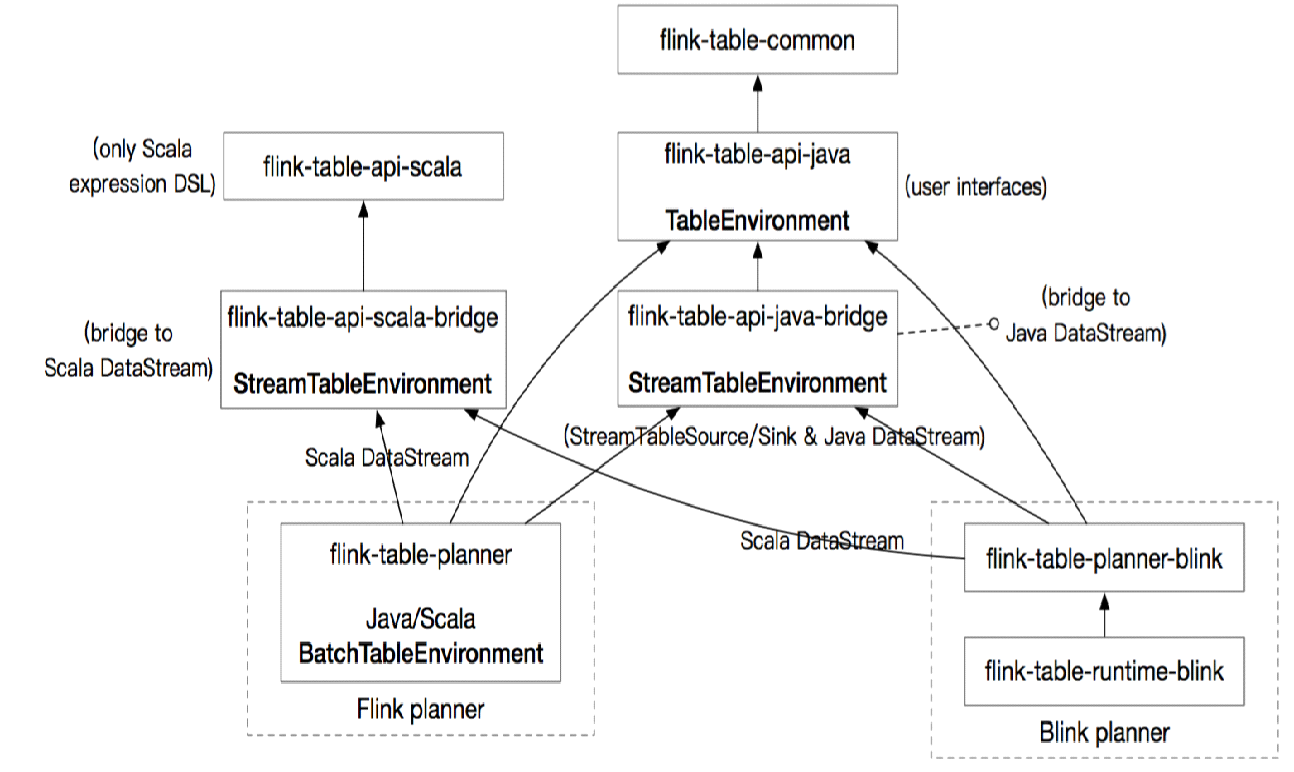
Figure 1 Overall design of the new TableEnvironment
As shown in Figure 1, TableEnvironment consists of the following parts:
In Flink versions earlier than v1.9, the Flink Table module has seven environments, making it complex to use and maintain. The seven environments are divided into StreamTableEnvironment and BatchTableEnvironment, with one of each for Java and for Scala, and three superclass environments.
Under the new framework, the community simplified the original design to unify batch and stream processing. Therefore, a unified TableEnvironment is provided. It is stored in the flink-table-api-java package. The bridges provide two StreamTableEnvironments used to connect Scala DataStream and Java DataStream. The BatchTableEnvironment is retained because the Flink planner still supports operations similar to toDataSet(). Currently, a total of five TableEnvironments are used.
The BatchTableEnvironment will be deprecated after the future removal of the Flink planner, leaving only three environments. This will make the TableEnvironment design more concise.
This section describes the scenarios and limitations of the new TableEnvironment.
The scenarios of the new TableEnvironment are shown in the following figure.
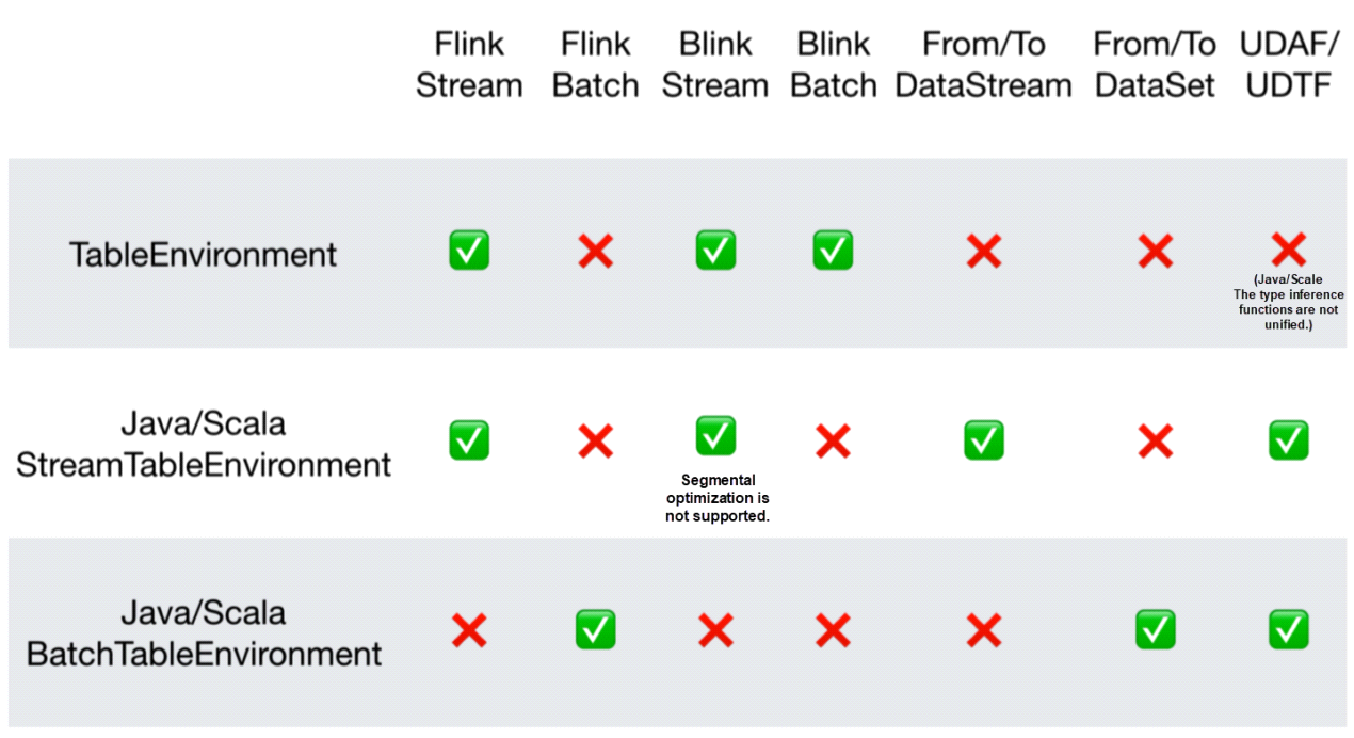
Figure 2 Scenarios of the new TableEnvironment
In the first line and afterward, the new TableEnvironment is referred to as UnifyTableEnvironment. In Blink, batch processing is a special case of stream processing, and hence UnifyTableEnvironment is applicable to Blink batch processing.
Flink 1.9 places some limitations on UnifyTableEnvironment. For example, UnifyTableEnvironment does not support the registration of user-defined aggregate functions (UDAFs) and user-defined table functions (UDTFs). In addition, UnifyTableEnvironment does not support the type inference function (which is not completed) of the new Type System and the type inference functions (which are not unified) of Java and Scala. These functions will be implemented in Flink 1.10. UnifyTableEnvironment cannot be converted to DataStream and DataSet.
In the second line, StreamTableEnvironment can be converted to DataStream and supports UDAF and UDTF registration. Java-compiled functions are registered to Java's TableEnvironment, and Scala-compiled functions are registered to Scala's TableEnvironment.
Blink batch jobs do not support StreamTableEnvironment because toAppendStream() is currently unavailable. Therefore, toDataStream() is not supported for the moment. As shown in the figure, only TableEnvironment is usable at present.
In the last line, BatchTableEvironment can be converted to DataSet by using toDataSet().
Figure 2 shows the scenarios and limitations of each TableEnvironment.
Let's take a look at each scenario using an example.
Example 1: Blink Batch
EnvironmentSettings settings = EnvironmentSettings.newInstance().useBlinkPlanner().inBatchMode().build();
TableEnvironment tEnv = TableEnvironment.create(settings);
tEnv...
tEnv.execute("job name");As shown in Figure 2, Blink batch processing only uses TableEnvironment, namely, UnifyTableEnvironment. In the code, you must first create an EnvironmentSetting and specify the use of the Blink planner and the Batch mode. Specify the Blink planner for Flink 1.9 because the JAR packages of the Flink planner and Blink planner are placed in Flink's lib directory. If you do not specify any planner, the framework does not know which planner to use. If the lib directory contains the JAR package of only one planner, you do not need to specify which planner to use.
Note, it's not possible to retrieve ExecutionEnvironment from UnifyEnvironment. This implies that you cannot use the executionEnvironment.execute() method to start tasks after writing a job flow. You must explicitly use the tableEnvironment.execute() method to start tasks, which is different from how jobs are started.
Example 2: Blink Stream
EnvironmentSettings settings = EnvironmentSettings.newInstance().useBlinkPlanner().inStreamingMode().build();
StreamExecutionEnvironment execEnv = ...
StreamTableEnvironment tEnv = StreamTableEnvironment.create(execEnv, settings);
tEnv⋯Blink streams use UnifyTableEnvironment and StreamTableEnvironment in a way similar to the Batch mode. You only need to replace inBatchMode with inStreamingMode.
Example 3: Flink Batch
ExecutionEnvironment execEnv = ...
BatchTableEnvironment tEnv = BatchTableEnvironment.create(execEnv);
tEnv⋯Flink batch processing is used in the same way as in Flink versions earlier than v1.9.
Example 4: Flink Stream
EnvironmentSettings settings = EnvironmentSettings.newInstance().useOldPlanner().inStreamMode().build();
TableEnvironment tEnv = TableEnvironment.create(settings);
tEnv...
tEnv.execute("job name");Flink streams support UnifyEnvironment and StreamTableEnvironment. While specifying a planner, you must specify useOldPlanner, namely, the Flink planner. OlderPlanner is so named because the Flink planner will be removed in the future. OlderPlanner only supports inStreamingMode, not inBatchMode.
FLIP-30 proposes the idea of creating a new catalog API. Moving ahead, ExternalCatalog will be deprecated. Blink planner no longer supports it, however, it is still supported by Flink planner
Figure 3 shows the overall design of the new catalog type.
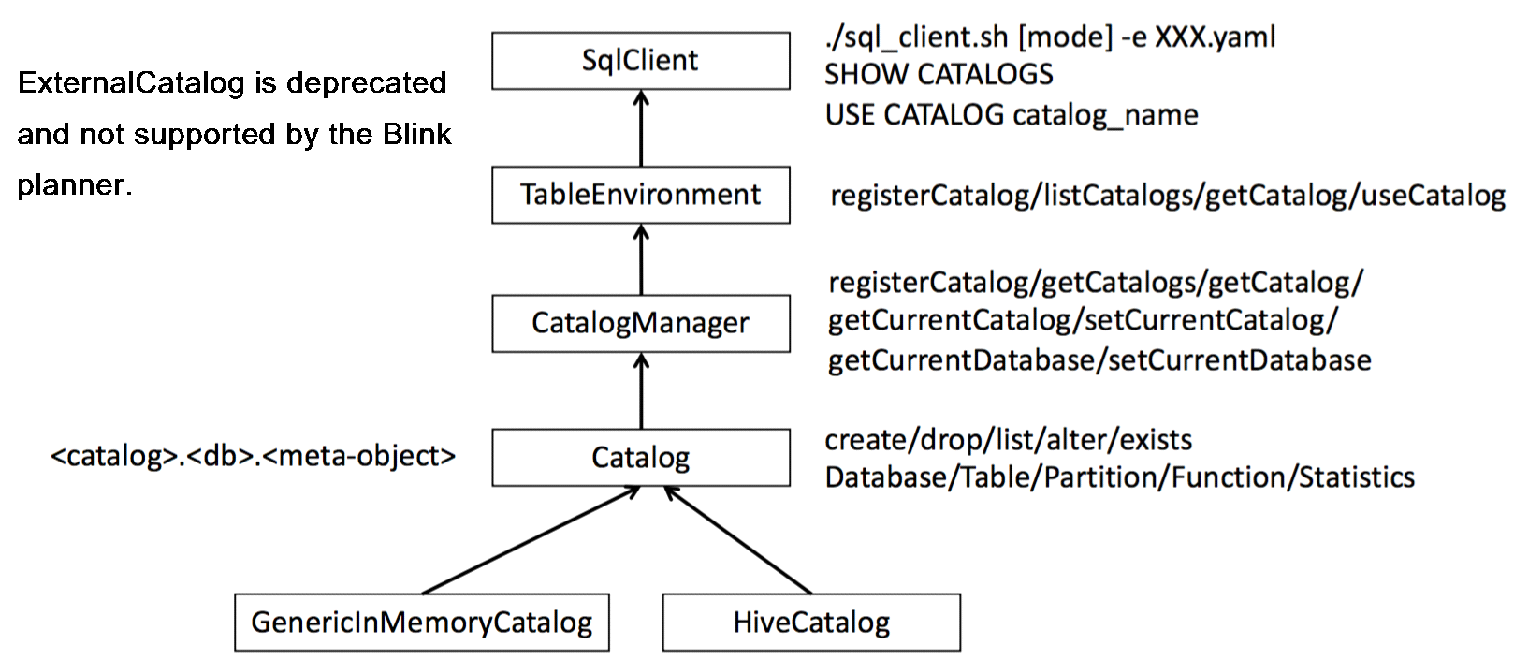
Figure 3 New catalog design
The new type of catalog consists of three layers (catalog_name.database_name.object_name). The top layer is the catalog name, the middle layer is a database, and the bottom layer includes all types of meta-objects, such as tables, partitions, and functions. It provides two built-in catalogs: MemoryCatalog and HiveCatalog. You may implement custom catalogs as needed.
How is the catalog used? A catalog supports statements, such as Create, Drop, List, Alter, and Exists, as well as operations on databases, tables, partitions, functions, and statistics. It also supports common SQL syntax.
CatalogManager is used to manage multiple catalogs simultaneously. It allows performing queries and associating operations across catalogs using the same SQL statement. For example, join A Hive Catalog and B Hive Catalog, making the Flink query process more flexible.
CatalogManager supports the following operations:
Though a catalog has three layers, you do not have to specify a value for each layer. Just write a table name, and the system uses getCurrentCatalog and getCurrentDatabase to obtain the default values to fill in the three layers. This simplifies the use of catalogs. To use a catalog other than the default one, call setCurrentCatalog.
The TableEnvironment layer supports the following catalog operations:
The SQL client layer also supports catalog operations, but with some limitations. You cannot use the Create statement to create a catalog directly. You must define a description in the YARN file to describe a catalog and then pass in -e +file_path when starting the SQL client to define the catalog. Currently, the SQL client supports some catalog operations, such as listing defined catalogs and using an existing catalog.
Operate the catalog content using DDL and execute DDL statements using the SQL client or the sqlUpdate() method of TableEnvironment.
The sqlUpdate() method supports the Create Table, Create View, Drop Table, and Drop View commands. It also supports the INSERT INTO statement.
The preceding four commands are explained as follows:
Currently, DDL does not support the definition of computed columns and watermarks, but this will be improved in later versions of Flink.
Create Table [[catalog_name.]db_name.]table_name(
a int comment 'column comment',
b bigint,
c varchar
)comment 'table comment'
[partitioned by(b)]
With(
update-mode='append',
connector.type='kafka',
...
)CREATE VIEW view_name AS SELECT xxx DROP TABLE [IF EXISTS] [[catalog_name.]db_name.]table_name CREATE VIEW
DROP VIEW
SHOW CATALOGS/DATABASES/TABLES/FUNCTIONS l USE CATALOG xxx
SET xxx=yyy
DESCRIBE table_name
EXPLAIN SELECT xxx Flink 1.9 provides mature DDL features, but some features will be improved in the future.
This section explains how to implement transformation to a JobGraph through the Table API and SQL to help you better understand the Blink planner, read Blink code, and use Blink. It also describes the improvements and optimizations made to the Blink planner.
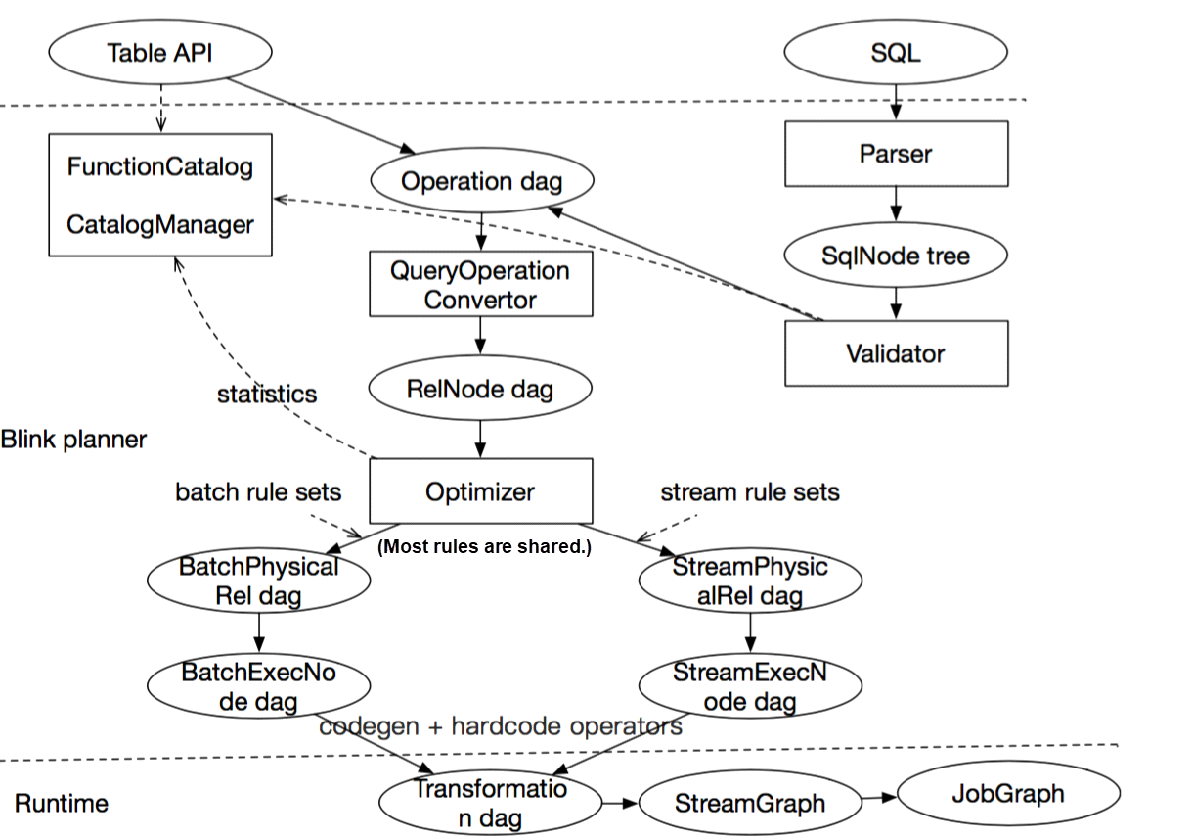
Figure 4 Main parsing process
Figure 4 shows the main parsing process, which consists of three layers: Table API and SQL, Blink planner, and runtime. The important phases of this process are explained as follows.
The Table API and SQL eventually transform the SQL statement into a unified structure, namely, the operation DAG.
The following improvements are made to the Blink planner:
The performance optimization of the Blink planner includes the following:
This section lists examples that allow us to analyze the design of the Blink planner after performance optimization.
Example 5
create view MyView as select word, count(1) as freq from SourceTable group by word; insert into SinkTable1 select * from MyView where freq >10;
insert into SinkTable2 select count(word) as freq2, freq from MyView group by freq; The preceding SQL statements are transformed into the following RelNode DAG:
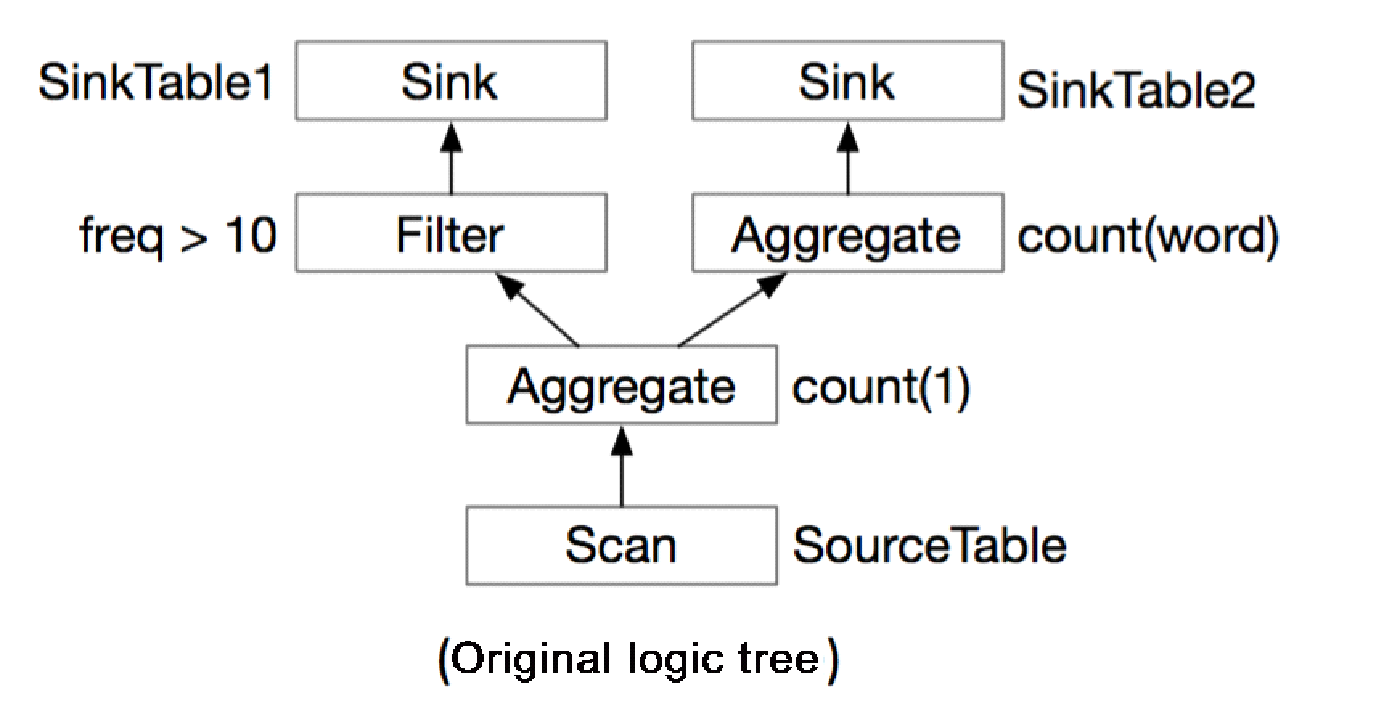
Figure 5 RelNode DAG for Example 5
If the Flink planner is used, the RelNode DAG can be optimized into the following execution DAG:
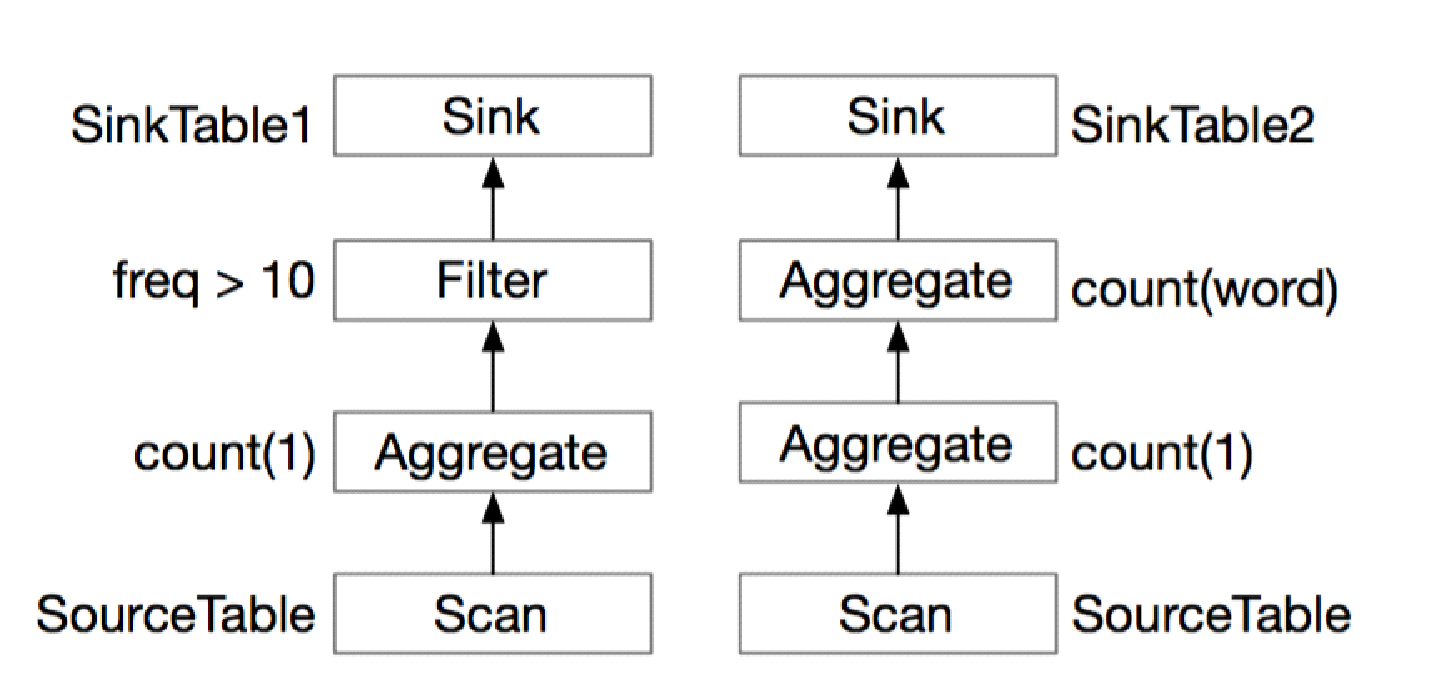
Figure 6 DAG using the Flink planner (Example 5)
The Flink planner implements reverse traversal that starts from the sink nodes and ends at the source nodes and it forms two separate execution links. As shown in Figure 5, repeated computations are performed on the scan node and the first-layer aggregate node.
If the Blink planner is used, the following execution DAG is generated after optimization:
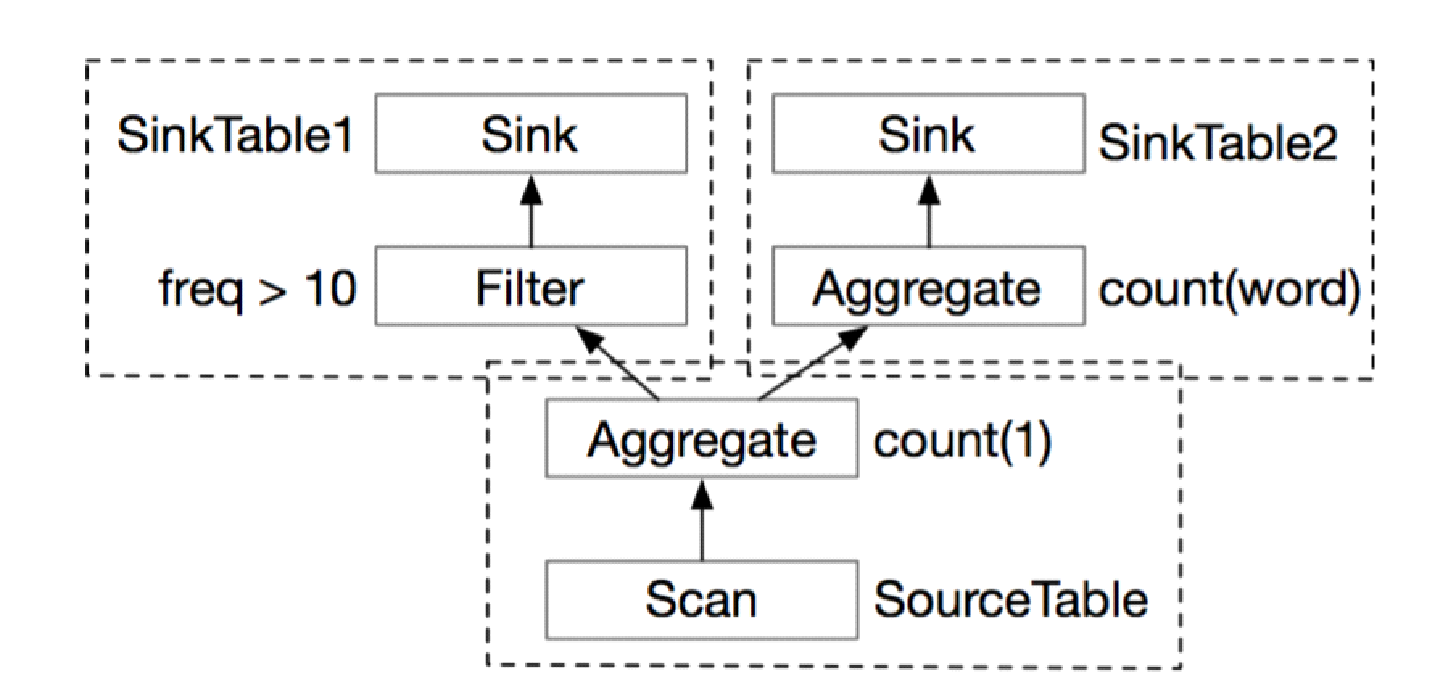
Figure 7 DAG using the Blink planner (Example 5)
The Blink planner caches all INSERT INTO operations and optimizes them only before execution. Figure 7 shows the complete execution DAG, in which some computations are repeated. The Blink planner identifies repeated computations by finding the maximum common subgraph that is optimized. After optimization, the Blink planner transforms the maximum common subgraph into a temporary table, which is used by other components.
In this way, the preceding DAG is divided into three parts: (1) maximum common subgraph (temporary table); (2) temporary table and optimization of the filter node and Sink Table 1; and (3) temporary table and optimization of the aggregate node and Sink Table 2.
The Blink planner finds the maximum common subgraph by using the declared view. During the development process, if you want to reuse a certain logic, define it as a view. This allows you to make full use of the Blink planner's segmental optimization function and reduce repeated computations.
Problems may occur during the optimization process. For example, some optimizations may be lost because the DAG is segmented in advance. Related algorithms will be optimized in the future.
To sum up, the segmental optimization of the Blink planner is essentially a multi-sink optimization or DAG optimization. In the case of single-sink optimization, optimizations can be made on all nodes, without having to segment the DAG.
Example 6
insert into SinkTabl
select freq from (select word, count(1) as freq from SourceTable group by word) t where word like 'T%'
union all
select count(word) as freq2 from (select word, count(1) as freq from SourceTable group by word) t group by freq; The SQL statements used in this example are similar to the SQL statements used for segmental optimization. In this example, the results are unionized to a single result table through the sink node.
Figure 8 shows the RelNode DAG after transformation.
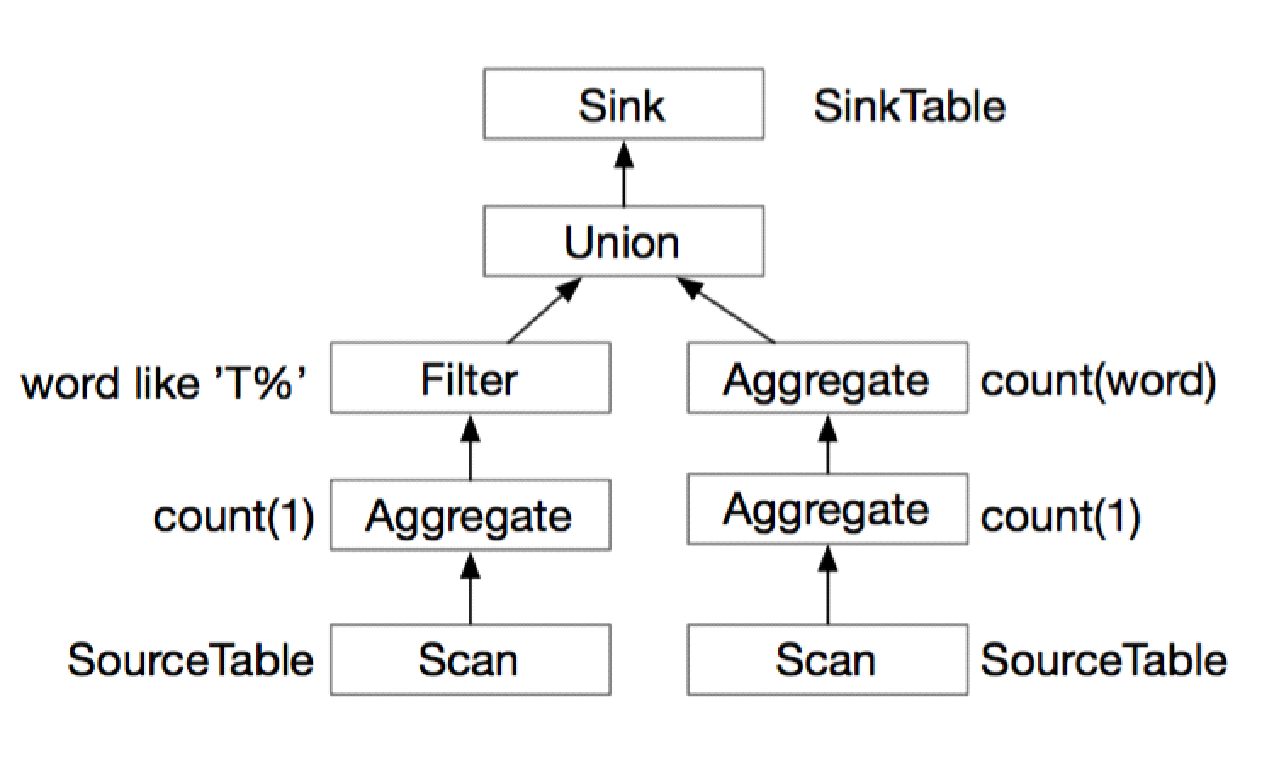
Figure 8 RelNode DAG for Example 6
As shown in Figure 8, repeated computations are performed on the scan node and the first-layer aggregate node. The Blink planner identifies these computations. The RelNode DAG is transformed as follows:
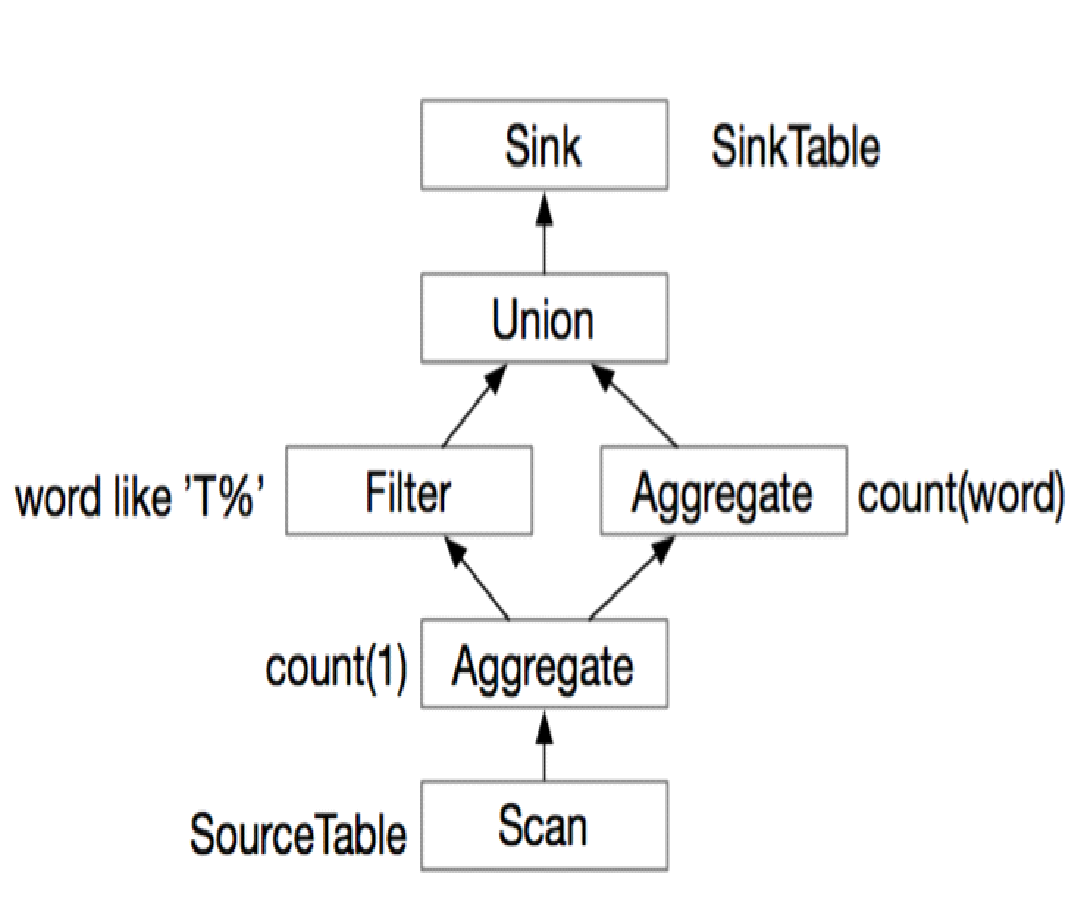
Figure 9 DAG using the Blink planner (Example 6)
The following two parameters are required to enable sub-plan optimization:
Disable the two parameters as needed. The table.optimizer.reuse-source-enabled parameter is explained as follows.
In Batch mode, a join operation may cause a deadlock. For example, the hash-join or nested-loop-join operator reads the build input and probe input in sequence. If reuse-source-enabled is enabled and the same data source is used, the data from this source is sent to the build input and probe input. The data of the build input is not consumed, so the join operation fails and the join process does not proceed.
To solve the deadlock problem and ensure normal data reading from the build input, the Blink planner writes the data of the probe input to a disk. Then, the Blink planner pulls data from the probe input only after all data is read from the build input. Writing data to a disk produces extra overhead. Reading data from the source twice may be completed before the write operation is completed. In this case, disable reuse-source for better performance. If the overhead of reading data from the source twice is much greater than that of a disk write operation, keep reuse-source on. The deadlock problem does not occur in Stream mode because the join operation in this mode does not involve edge selection.
The sub-plan reuse feature solves the problem of subgraph reuse after optimization. It is similar to and complements segmental optimization.
Note
Hash Join: If you want to join two tables, namely, t1 and t2, select one of these two tables and create a hash table based on the columns provided by the join clause. Then, scan the other table by row and check whether the hash table contains equivalent rows for the join operation. This process is called a probe. The first table is called the build table, and the second table is called the probe table.
Blink provides a variety of aggregate operations:
Group Agg helps in implementing the following two optimizations:
1) Optimization Through Local Agg and Global Agg
Local Agg and Global Agg are used to reduce network shuffles. The following conditions must be met for optimization through Local Agg and Global Agg:
Example 7
select count(*) from t group by colorWithout optimization, the following aggregate operation results in 10 shuffle operations:
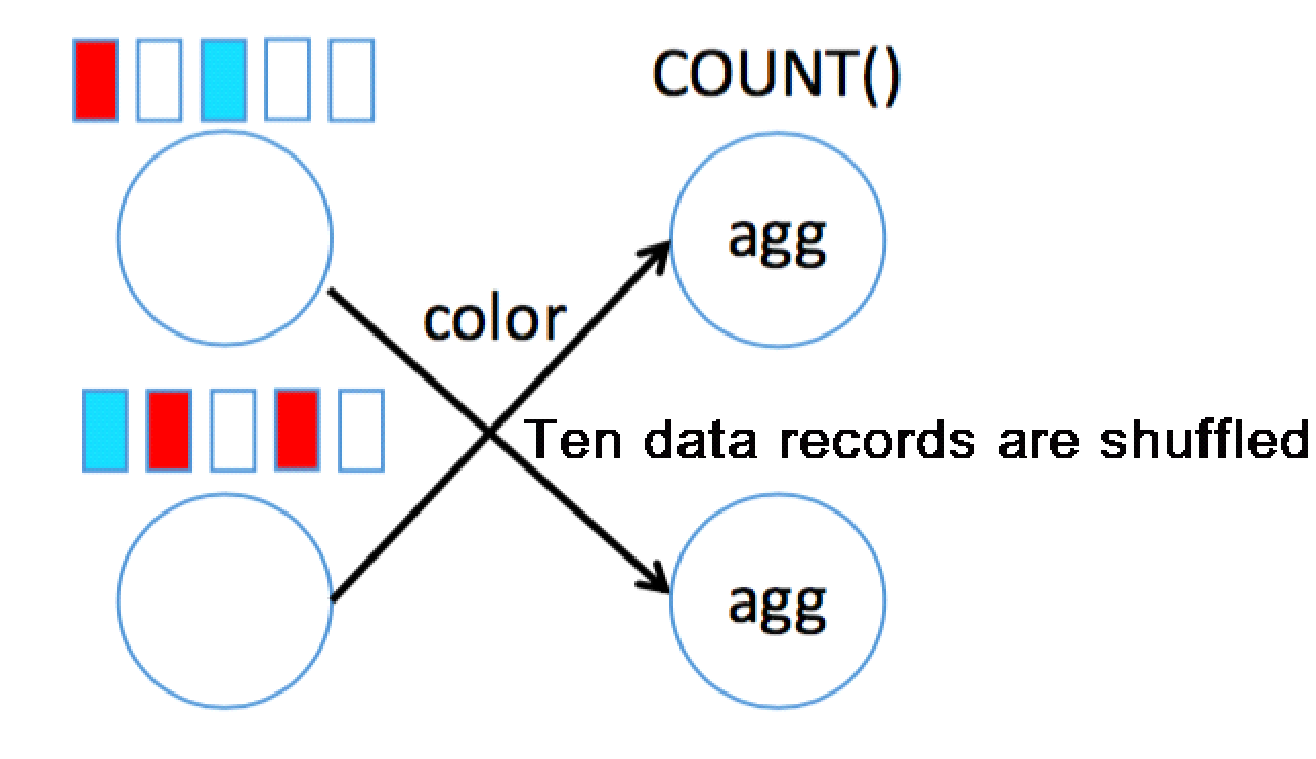
Figure 10 Unoptimized Count operation (Example 7)
Figure 11 shows the operations after Local Agg and Global Agg are used. The local aggregate operation and the shuffle operation are performed in sequence. Only six data records are shuffled. In Stream mode, Blink pre-aggregates the results through mini-batch and sends the results to Global Agg for a summary.
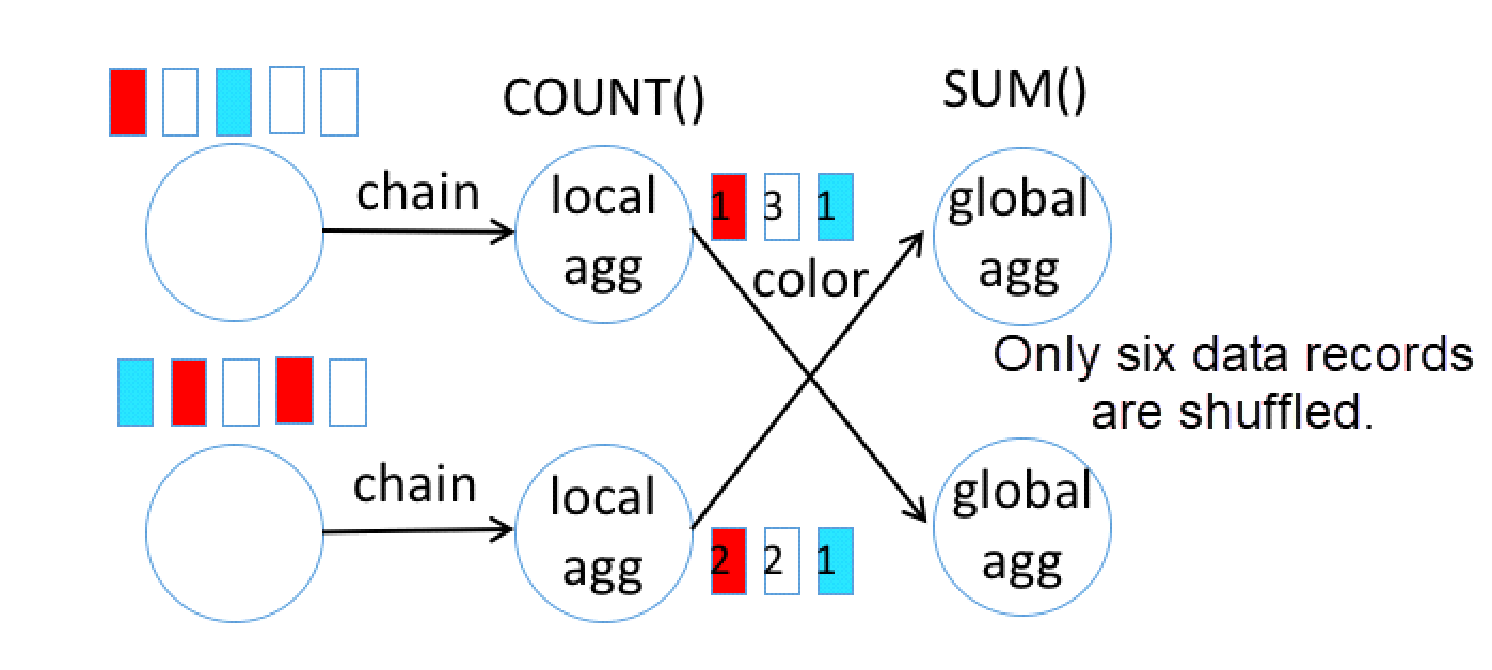
Figure 11 Count operation after Local Agg and Global Agg are used (Example 7)
2) Optimization Through Distinct Agg
Distinct Agg is used to perform optimizations by rewriting SQL statements. However, the optimization method varies between the Batch mode and Stream mode.
Batch Mode
The value of Distinct and the value of the non-Distinct Agg function are evaluated. Then, the value of the Distinct Agg function is evaluated.
Example 8
select color, count(distinct id), count(*) from t group by colorManually rewrite the preceding code as follows:
select color, count(id), min(cnt) from (
select color, id, count(*) filter (where $e=2) as cnt from (
select color, id, 1 as $e from t --for distinct id
union all
select color, null as id, 2 as $e from t -- for count(*)
) group by color, id, $e
) group by color Figure 12 shows the logical transformation process.
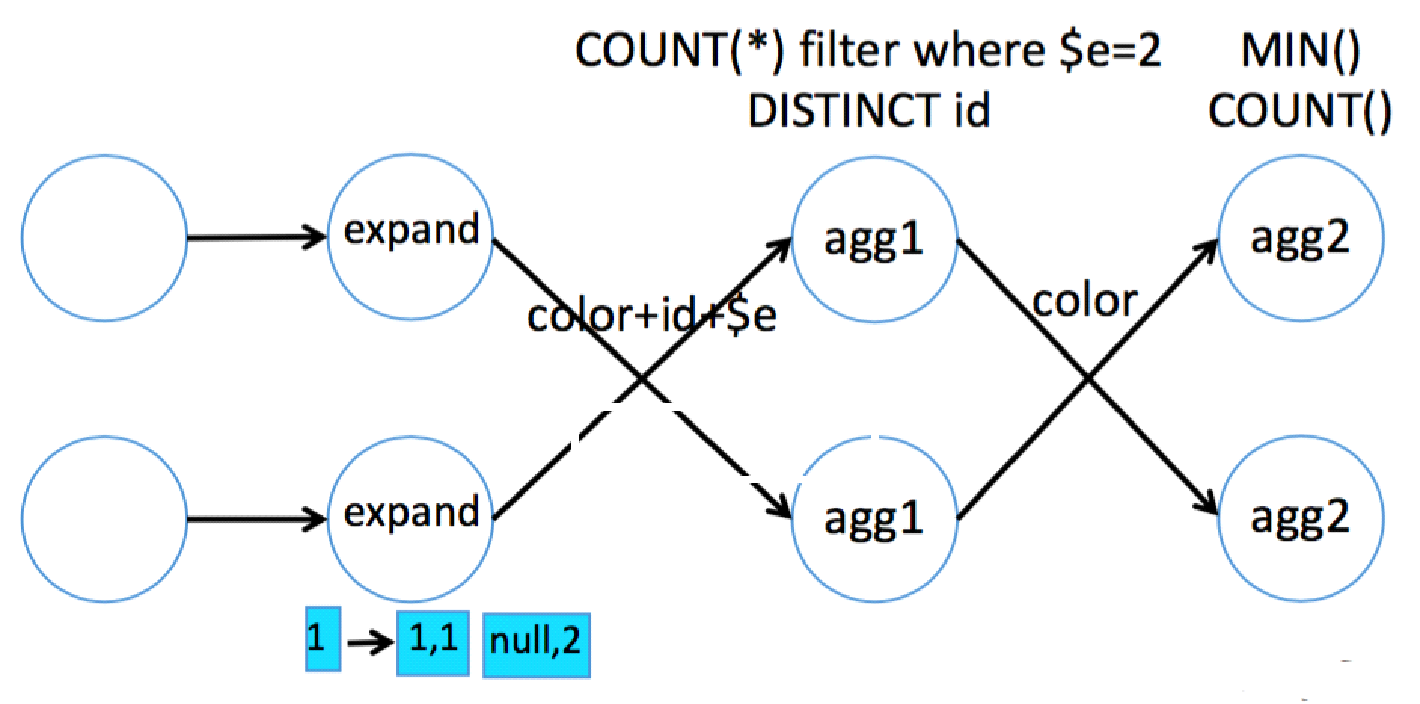
Figure 12 Distinct-based rewriting logic in Batch mode (Example 8)
Stream Mode
The following conditions must be met to enable the Stream mode:
Example 9
select color, count(distinct id), count(*) from t group by color Manually rewrite the preceding code as follows:
select color, sum(dcnt), sum(cnt) from (
select color, count(distinct id) as dcnt, count(*) as cnt from t
group by color, mod(hash_code(id), 1024)
) group by colorFigure 13 shows the logical graph before the code is rewritten.
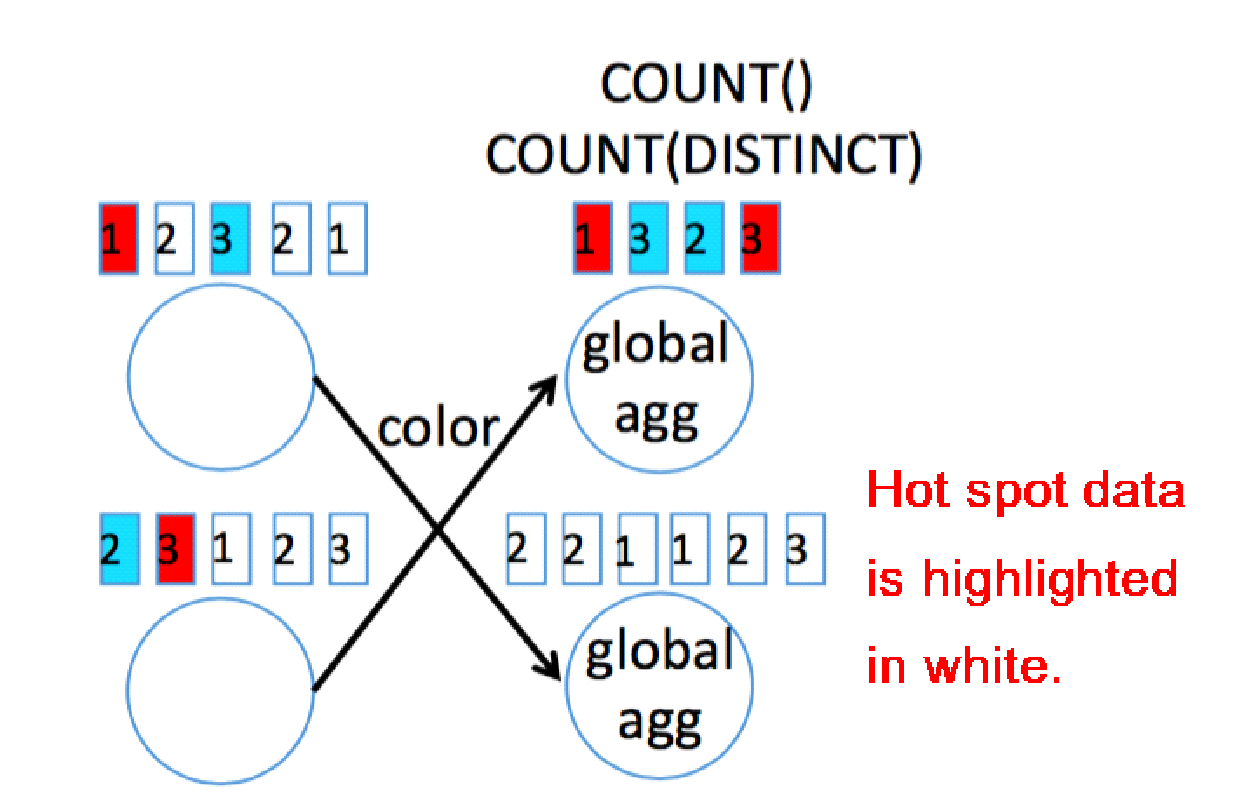
Figure 13 Logical graph in Stream mode before Distinct-based optimization (Example 9)
Figure 14 shows the logical graph after the code is rewritten. Hot spot data is distributed to multiple intermediate nodes.
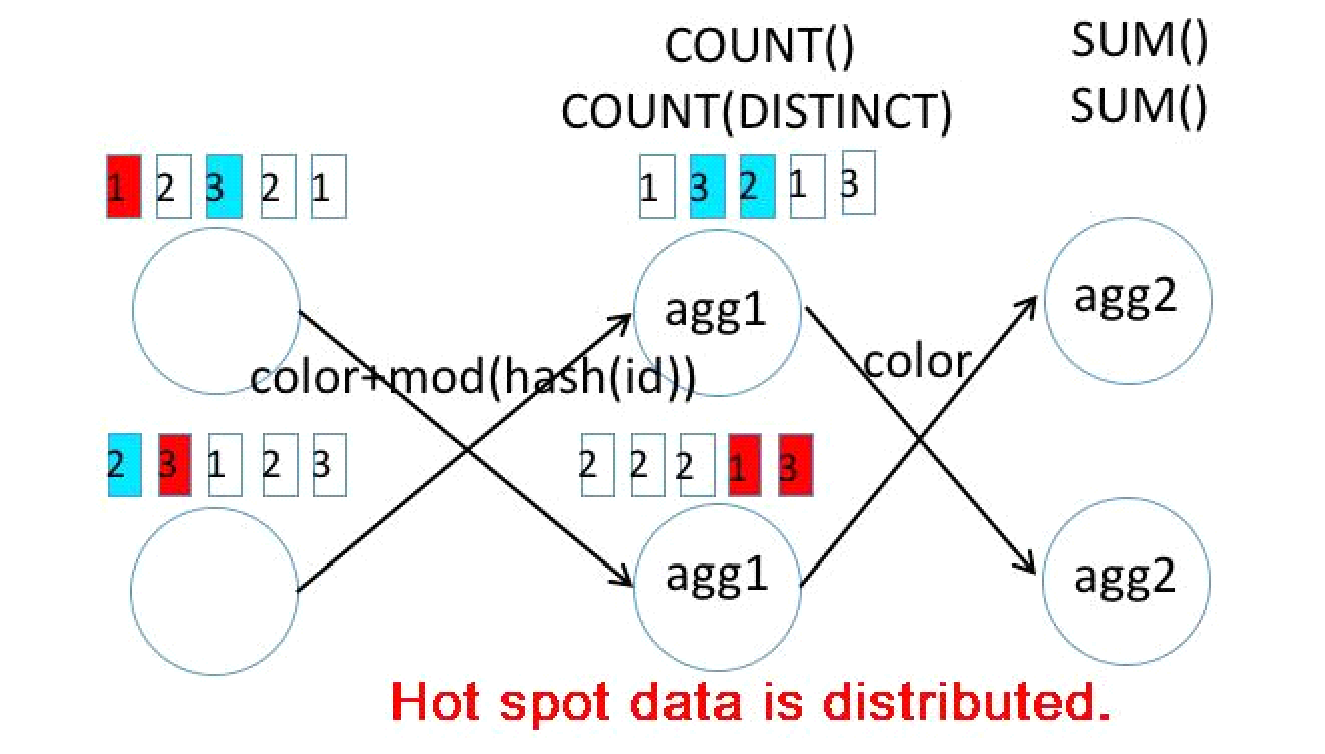
Figure 14 Logical graph in Stream mode after Distinct-based optimization (Example 9)
In Example 5, the value 1024 in mod(hash_code(id), 1024) of the SQL statement indicates the distribution dimension. We recommend setting it to greater value for better optimization performance.
This article introduces the overall design of the new TableEnvironment, lists the TableEnvironment choices in various modes, provides examples to explain how to write code in these modes, and points out some coding precautions.
It also provides examples to explain the overall design of the new catalog type and DDL usage. Finally, it describes the process of parsing through the Table API and SQL on the Blink planner as well as the improvements and optimizations made to the Blink planner. I hope that this article helps you understand and use Flink SQL.
Best Practices and Tips for Working with Flink State: Flink Advanced Tutorials

206 posts | 54 followers
FollowApache Flink Community - July 28, 2025
Apache Flink Community China - August 2, 2019
Apache Flink Community China - September 16, 2020
Alibaba Cloud Big Data and AI - October 27, 2025
Apache Flink Community - August 14, 2025
Apache Flink Community - March 20, 2025

206 posts | 54 followers
Follow Realtime Compute for Apache Flink
Realtime Compute for Apache Flink
Realtime Compute for Apache Flink offers a highly integrated platform for real-time data processing, which optimizes the computing of Apache Flink.
Learn More Message Queue for Apache Kafka
Message Queue for Apache Kafka
A fully-managed Apache Kafka service to help you quickly build data pipelines for your big data analytics.
Learn More Super App Solution for Telcos
Super App Solution for Telcos
Alibaba Cloud (in partnership with Whale Cloud) helps telcos build an all-in-one telecommunication and digital lifestyle platform based on DingTalk.
Learn More Media Solution
Media Solution
An array of powerful multimedia services providing massive cloud storage and efficient content delivery for a smooth and rich user experience.
Learn MoreMore Posts by Apache Flink Community